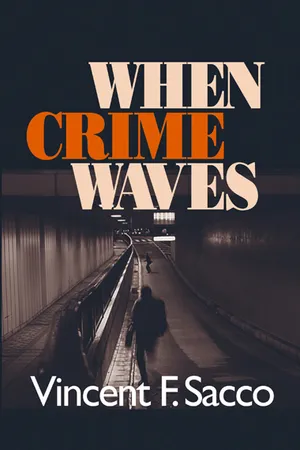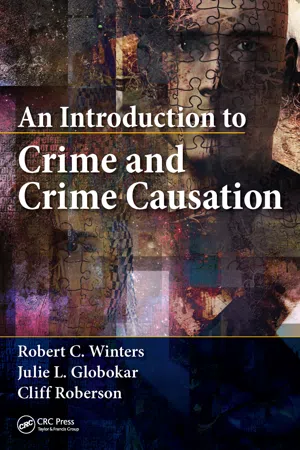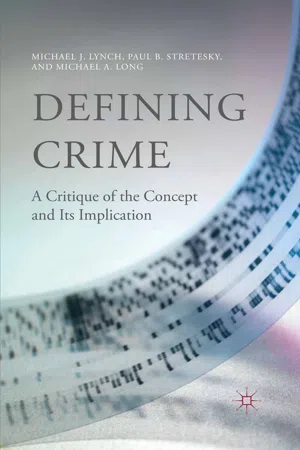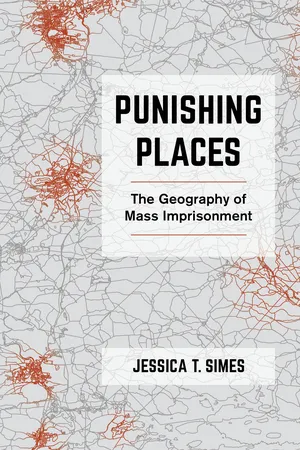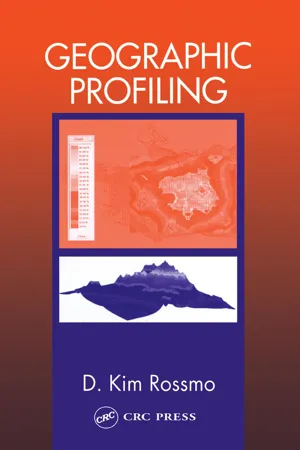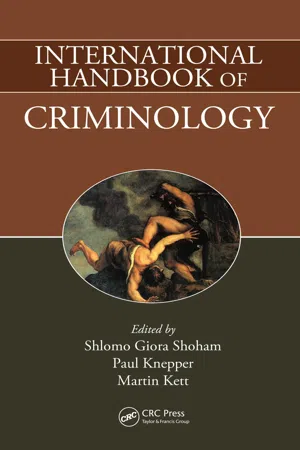Social Sciences
Social Distribution of Crime
Social distribution of crime refers to the unequal distribution of criminal behavior across different social groups and locations. It examines how factors such as race, socioeconomic status, and neighborhood characteristics influence the likelihood of individuals engaging in criminal activities. This concept is central to understanding the social causes and consequences of crime within a society.
Written by Perlego with AI-assistance
Related key terms
1 of 5
6 Key excerpts on "Social Distribution of Crime"
- eBook - PDF
- Vincent F Sacco(Author)
- 2005(Publication Date)
- SAGE Publications, Inc(Publisher)
Over the years, criminologists have devel-oped many explanations intended to make sense of the crime patterns we observe. The general bias in criminological theorizing has been to emphasize stability rather than change. In other words, most theories seek to explain why particular kinds of patterns of crime exist at any one point in time rather than why they change over time. For our purposes, however, arguments about shifts 28 — WHEN CRIME WAVES Why Do Crime Rates Go Up and Down? — 29 in levels of crime are arguments about (relatively rapid) social change. Three types of change processes are the focus of attention in this chapter: dislocation, diffusion, and innovation. The general point is that crime levels vary along with these social and cultural processes. Our starting point in this discussion is the nonrandom character of involvement in criminal events. The Demography of Offending Demography is a field of study that focuses on the ways in which populations are structured and how they change over time. Demographers attempt to understand how changes in birth rates or death rates or how varying patterns of immigration or migration determine who makes up the population at particu-lar historical moments. Why should any of this matter to us? For a simple rea-son: We know from a very large amount of research evidence that the risks of committing a crime, and the risks of being a victim of crime, are not randomly distributed in any population. The members of some social categories are much more likely to be involved in criminal events than are the members of other social categories. Of course, this is contrary to what the media often tell us. Dramatic television, reality programs, and the nightly news often encourage us to think about crime as a totally random occurrence (Best, 1999). It isn’t. The recognition that crime is nonrandomly distributed in populations has a very significant implication. - eBook - PDF
- Robert C. Winters, Julie L. Globokar, Cliff Roberson(Authors)
- 2014(Publication Date)
- Routledge(Publisher)
87 chapter five Social structures as a cause of crime Chapter objectives After studying this chapter, the reader should be able to • Explain how the social structural approach differs from other criminological perspectives • Identify the main contributions of the social structural perspective • Discuss the relationship of urban growth to criminality • Explain the concept of social disorganization • Describe broken windows theory • Compare and contrast the social disorganization, strain, and subcultural traditions • Describe how American cities have changed since the early 1900s, and its relevance for understanding crime • Identify weaknesses of the social structural perspective Introduction This chapter presents social structural explanations of crime. It has long been recognized that crime is not evenly distributed across space, with studies dating back to the early 1800s observing higher rates of crime in cities compared to rural areas. 1 The theories in this chapter attempt to explain that spatial pattern by looking to the dynamics of social status, relationships, and social institutions such as the economy and family. The assumptions of social structural theorists include the following: • Crime is a normal response to certain social conditions. • Social problems tend to cluster among structurally disadvantaged populations, and particularly within areas of concentrated disadvantage. • Crime is most likely to occur in neighborhoods with deteriorated housing, low rates of home ownership, high rates of residential mobility, and low collective efficacy. • Race- and class-based social exclusion perpetuates disadvantage and, by extension, encourages crime. • Crime can be reduced through neighborhood-level interventions and changes in the overall social structure. Structural disadvantage can lead to crime via three mechanisms, which form the subcat-egories of this perspective. - eBook - PDF
Defining Crime
A Critique of the Concept and Its Implication
- M. Lynch, P. Stretesky, M. Long(Authors)
- 2016(Publication Date)
- Palgrave Macmillan(Publisher)
This is because the relative definition of crime includes some limits that relate to the social aspects of the production of crime. By production of crime, we mean the social influences that affect crime such as law and its enforcement and how those factors 118 DEFINING CRIME intersect with behaviors that come to be defined as crime. We begin with the relative definition of crime. A Relative Definition of Crime We begin this discussion with an observation about the utility of relative definitions of crime; they are useful to the extent that they can address variations in crime related to the influence of structural, cultural, political, and historical forces and can address issues related to the variability in the definition of crime that the legal definition of crime approach ignores. Relative definitions of crime, especially if derived from the criminal law, would specifically address the fact that the definition of crime is a social construction and that the process of the social construction of crime forces the criminal law to vary across time and place. In the relative view of crime, it is a core assumption that the legal definition of crime is not an absolute and unchanging concept. Rather, the core assumption of a relative definition of crime is that the legal definition of crime is very likely to vary across time and place as a reflection of social, economic, and political conditions of life and the variations in those structural forces as they influence the content and structure of law. As a social, political, and economic entity, we can expect or hypothesize that crime will vary with structural circumstances. There is some significant appeal to this idea. Certainly, if one exam- ines the criminal law over time and across places, its variability is quite evident. It might be popular to chalk up that variation to cultural dif- ferences, but that explanation is wanting on a number of grounds. - eBook - PDF
Punishing Places
The Geography of Mass Imprisonment
- Jessica T. Simes(Author)
- 2021(Publication Date)
- University of California Press(Publisher)
69 Driven in large part by the contributions of urban inequality and social con-trol scholars I have described, incarceration is now largely defined as a facet of spatially concentrated disadvantage in urban places marked by poverty, job-lessness, population turnover, racial segregation, heightened surveillance, and criminalized violence. These criminal and civil disorder codes, police prac-tices, and economic blight fell upon the US urban population, so research on the social problem of spatially concentrated incarceration has been almost entirely conducted within the bounds of large urban areas and has resulted almost entirely in freestanding case studies of specific cities. For those who hope to understand rates of criminal justice involvement, there are significant costs to studying just one type of geography. For example, studying areas with low levels of incarceration deepens and broadens our understanding of social inequality. We can learn much from comparisons of places with, say, similar socioeconomic conditions but different levels of incarceration, which might be instructive when it comes to policy reforms aimed at reducing the footprint of the criminal justice system. By limiting samples to large urban cities, scholars have essentially cut out whole swaths of the population in places at the extremes of the distribution—places with very low and very high rates of incarceration. Empirically, this practice has gener-ated biased estimates of the social disadvantage–incarceration association, and it has certainly underestimated social inequality. 70 Theory has yet to offer satisfying explanations of high rates of incarceration beyond major metro areas, though researchers—especially those reckoning with the surge of social movements aimed at police violence, reform, and even abolition—have begun to explore suburban contexts. 71 John Eason’s research, - Available until 5 Dec |Learn more
- D. Kim Rossmo(Author)
- 1999(Publication Date)
- Routledge(Publisher)
The geog-raphy of crime encompasses the study of the spatial and temporal distribution of criminal offences. The methodological and theoretical approaches developed in a variety of disciplines are often adopted to the study of crime and criminals, and the fields of geography and urban analysis provide several analytical tools for criminologists. Perspectives that make particular use of geographic tech-niques include the social ecology qf crime, environmental criminology, geog-raphy of crime, routine activity approach, situational crime prevention, and 97 98 Geographic Profiling problem-oriented policing (Brantingham & Brantingham, 1981b; Branting-ham & Jeffery, 1981; R. V. Clarke, 1992, 1997; Felson, 1986; Goldstein, 1990; Lowman, 1986; Smith, 1986). Work in such areas has provided the conceptual foundations for geographic profiling. 7 .1 Geography and Crime Studies Geographical patterns in crime have been noted since the mid-19 th century pioneering work of Andre-Michel Guerry and Lambert-Adolphe Quetelet who mapped, on a national basis, violent and property offences and exam-ined their spatial relationship to poverty (Brantingham & Brantingham, 1981c; Vold & Bernard, 1986). The most famous spatial crime studies were conducted in the early 20 th century, when the city of Chicago served as an inspiration source and a field of experimentation for University of Chicago sociologists (Warren, 1972; Williams & McShane, 1988). The geographical focus of criminology had shifted from regional areas to city neighbourhoods. The Chicago School's human ecology and theories of urban growth, developed by Robert Park and Ernest Burgess, served as guides for former probation officer Clifford R. Shaw and his colleague Henry D. McKay (Brant-ingham & Brantingham, 1984; Vold & Bernard, 1986). - eBook - PDF
- Shlomo Giora Shoham, Paul Knepper, Martin Kett(Authors)
- 2010(Publication Date)
- Routledge(Publisher)
If social class is related to nontrivial criminal offending in these egalitarian societies, one would expect even stronger effects in nations with more intense levels of poverty. 19.3.2 Community Context of Class and Crime The self-report method can also be criticized for a narrow conceptualization of social class. Most self-report studies treat social class as an individual- or a family-level attribute, ignoring the fact that the community context of social disadvantage plays a critical role in many sociological explanations of crime [Shaw and McKay 1942; Sampson and Groves 1989; Blau and Blau 1982]. Research by Robert Crutchfield [1995; Crutchfield and Pitchford, 1997] suggests that the social structure of the residential area has a lot to do with the impact of a person’s social class on criminal offending. For example, mar-ginal labor market status does not appear to contribute to criminal behavior for individuals living in a suburban middle-class neighborhood. However, the consequences of unemployment are different if the same individual is embedded in a community with a critical mass of similarly situated peers: thus,“when they spend substantial amounts of time with other marginally employed people in bars, on street corners, or pool halls, they are more likely to be involved in crime” [Crutchfield, 1995:205]. Much of recent community-level research on social class and crime has been motivated by the desire to understand why disadvantaged neigh-borhoods have more crime [Bellair, 1997 and 2000; Kubrin and Weitzer, 2003]. Blending elements from contemporary social disorganization theory [Sampson and Groves, 1989] and Coleman’s social capital theory [1990], the theory of collective effi cacy is a sophisticated example of this literature [Sampson, Raudenbush, and Earls, 1997]. Informal social control enacted under conditions of social trust is the key causal mechanism in this theory [Sampson, 2004].
Index pages curate the most relevant extracts from our library of academic textbooks. They’ve been created using an in-house natural language model (NLM), each adding context and meaning to key research topics.
